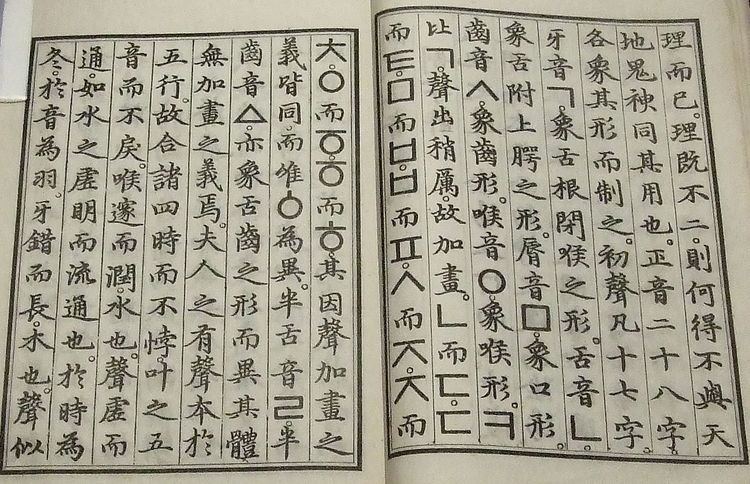 | ||
McCune–Reischauer romanization ( /məˈkuːn ˈraɪ.ʃaʊ.ər/) is one of the two most widely used Korean language romanization systems. A modified version of McCune–Reischauer was the official romanization system in South Korea until 2000, when it was replaced by the Revised Romanization of Korean system. A variant of McCune–Reischauer is still used as the official system in North Korea.
Contents
- Characteristics and criticism
- Guide
- Vowels
- Consonants
- Examples
- Exceptions that do not exactly follow pronunciation
- North Korean variant
- South Korean variant
- Other systems
- References
The system was created in 1937 by George M. McCune and Edwin O. Reischauer. With a few exceptions, it attempts not to transliterate Korean hangul but to represent the phonetic pronunciation. McCune–Reischauer is widely used outside Korea.
Characteristics and criticism
Korean has phonologically no distinction between voiced and voiceless consonants, but it phonetically distinguishes them. Aspirated consonants like p', k', and t' are distinguished by apostrophe from unaspirated ones, which may be falsely understood as a separator between syllables (as in 뒤차기 → twich'agi, which consists of the syllables twi, ch'a and gi). The apostrophe is also used to mark transcriptions of ㄴㄱ (n'g) as opposed to ㅇㅇ (ng): 잔금 → chan'gŭm vs. 장음 → changŭm).
Critics of the McCune–Reischauer system claim that casual users of the system omit the breves ( ˘ ) over the o for 어 and the u for 으 because typing o or u without the breves is often easier than adding them. That can lead to confusion over whether the o being romanized is 오 or 어 or the u being Romanized is 우 or 으. Casual users also often omit the apostrophe that differentiates aspirated consonants (ㅋ, ㅌ, ㅍ, and ㅊ) from their unaspirated counterparts (ㄱ, ㄷ, ㅂ, and ㅈ), which can also lead to confusion.
Defenders of the McCune–Reischauer system, however, respond that even if it is still best to include breves and apostrophes, even when they are omitted, a casual user unfamiliar with Korean can easily approximate the actual pronunciation of a Korean word.
Such common omissions were the primary reason the South Korean government adopted a revised system of romanization in 2000. Critics of the revised system claim it fails to represent 어 and 으 in a way that is easily recognizable. Also, it misrepresents the unaspirated consonants the way that they are actually pronounced.
Meanwhile, despite official adoption of the new system in South Korea, many in the Korean Studies community, both inside and outside South Korea and international geographic and cartographic conventions generally continue to use either the McCune–Reischauer or the Yale system. Also, North Korea uses a version of McCune–Reischauer.
Even within South Korea, usage of the new system is less than universal, like the variant of McCune–Reischauer that was the official Romanization system between 1984/1988 and 2000.
Guide
This is a simplified guide for the McCune–Reischauer system. It is often used for the transliteration of names but does not convert every word properly, as several Korean letters are pronounced differently depending on their position.
Vowels
Consonants
For ㄱ, ㄷ, ㅂ, and ㅈ, the letters g, b, d, or j are used if voiced, k, p, t, or ch otherwise. Pronunciations such as those take precedence over the rules in the table above.
Examples
Exceptions that do not exactly follow pronunciation
North Korean variant
In North Korea's variant of McCune–Reischauer, aspirated consonants are not represented by an apostrophe but are instead by adding an "h". For example, 평안 is written as Phyŏngan. The original system would have it written as P'yŏngan.
South Korean variant
A variant of McCune–Reischauer was in official use in South Korea from 1984 to 2000. The following are the differences between the original McCune–Reischauer and the South Korean variant:
The following table illustrates the differences above.
Other systems
A third system, the Yale Romanization system, which is a transliteration system, exists but is used only in academic literature, especially in linguistics.
The Kontsevich system, based on the earlier Kholodovich system, is used for transliterating Korean into the Cyrillic script. Like McCune–Reischauer romanization it attempts to represent the pronunciation of a word, rather than provide letter-to-letter correspondence.
